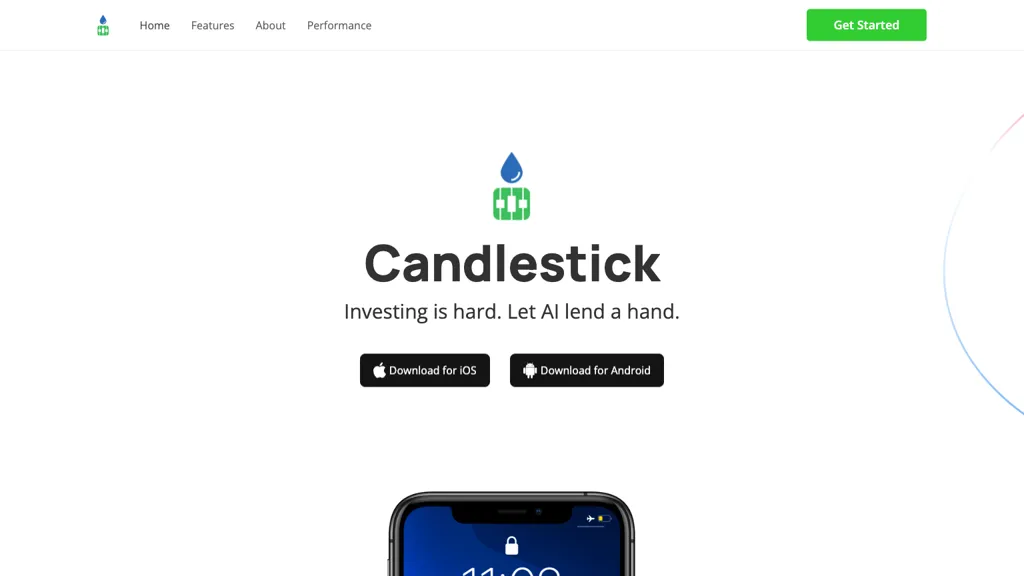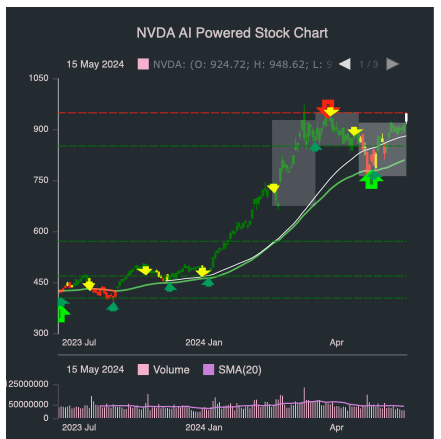20 Great Advice To Picking AI Stock Trading Platform Websites
20 Great Advice To Picking AI Stock Trading Platform Websites
Blog Article
Top 10 Tips When Evaluating Ai Trading Platforms Based On Their User Interfaces And Experiences
The User Interface (UI) and the User Experience (UX) of AI platforms for predicting and analyzing stocks are essential to making sure that they are efficient, usable as well as general satisfaction. Even the AI models are reliable, a poorly designed interface could hinder the process of making decisions. Here are the 10 best tips for evaluating the UI/UX.
1. Examine the intuitiveness and ease of Utilization
Navigation: Make sure that the platform is easy to use, using buttons and menus that are simple to comprehend and workflows that are easy to follow.
Learning curve: Measure the speed at which an individual is able to master a system and learn to use it without lengthy instruction.
Check for consistent designs (e.g. color schemes and buttons) across all platforms.
2. Check for Customizability
Dashboard customization: Find out whether dashboards are customizable to display data, charts and metrics that are relevant for the user.
Layout flexibility: Ensure that your platform permits you to change the layout of widgets, tables and charts.
Look up the platform's dark/light choices or preferences for visuals.
3. Visualize data quickly and easily
Quality of the chart: Make sure whether the platform provides interactive charts with zooming and panning capabilities (e.g. line charts, candlestick charts).
Visual clarity: Check that the data is presented clearly, with appropriate labels as well as legends and tooltips.
Check that the visualisations are constantly updated to reflect any changes on the market.
4. Test for Reactivity and Speed
When working with huge data sets and complex calculations, the system should be able to load fast.
Real-time performance: Determine if your platform can handle data feeds which are updated in real-time without delays or lag.
Cross-device compatability: Check to see if your platform works across all devices (desktops and mobiles as well as tablets).
5. Examine Accessibility
Look through the mobile application to see if it offers all of the features you require for on-the go trading.
Keyboard shortcuts: Make sure the platform supports keyboard shortcuts to advanced users.
Accessibility features - Verify that the application is in compliance with accessibility standards.
6. Use the Examine Search and Filtering Function to examine your information.
Search functionality: Make sure that the platform allows users to quickly search for stocks, indexes, and other investments.
Advanced filters: Find out if the user can apply filters to narrow results (e.g. by capitalization, sector, performance metrics).
Saved searches. Verify the platform's ability to allow users to store frequently-used search terms or filters.
7. Make sure you are aware of alerts and notifications.
Customizable alerts. Users can set alerts for specific situations (e.g. prices thresholds, spikes in volume).
Notification delivery: Make sure that alerts are being sent through multiple methods, e.g. SMS, emails, or in-app notifications.
Alerts are timely: Ensure that they are promptly and precisely sent.
8. Assessment of Integration to Other Tools
Broker integration - Check that your platform is seamlessly integrated with your brokerage in order to allow the quick execution of trades.
API access: Find out whether advanced users have access to the API to create their own customized software or workflows.
Third-party integrations : Find out whether the platform is compatible with other applications, like Excel, Google Sheets or trading bots.
9. Assessment Help and Support Features
Tutorials for onboarding - Check to see if there are tutorials and walkthroughs available for those who are brand new.
Help center. Make sure your platform comes with an extensive help center.
Support for customers - Find out if the platform has a an efficient assistance (e.g. email, live chat).
10. Test for Overall Satisfaction of Users
User feedback: Read reviews and testimonials from users to determine overall satisfaction with the platform's UX/UI.
Trial period for free: Try the platform for free and test its functionality.
Error handling: Check how the platform handles edge cases or errors (e.g. invalid inputs and downtime of servers).
Bonus Tips
Aesthetics. While practical design is essential but a visually appealing design can enhance user experience.
Performance under stress: Ensure that your platform is responsive and stable during times of market volatility.
Check for active forums and communities. Users can share their thoughts and suggestions on these forums and communities.
Utilize these guidelines and you can assess the UX/UI of AI-based stock prediction and analysis trading platforms. They will be user-friendly efficient, and effective, as well as aligned your trading needs. A good UI/UX can be an effective tool that will assist you in making more informed decisions and make better trades. Have a look at the top article source for ai for investment for website tips including ai stock market, best ai stock, ai investing, ai investment platform, options ai, best ai trading app, ai trade, ai stock trading bot free, ai stock trading bot free, best ai trading software and more.
Top 10 Tips For Assessing The Risk Management Of Stock Trading Platforms That Use Ai
Risk management plays an essential role in any AI-based platform for trading stocks. It safeguards your investment by limiting the risk of losses and helps you to maximize profits. A platform that has robust risk management tools can assist you in navigating market volatility and make well-informed choices. Below are the top 10 suggestions to evaluate the risk management capabilities of these platforms:
1. Study Stop-Loss Features and Take Profit features
Levels that can be customized - Make sure that the platform allows you to modify your stop-loss, take-profit and profit levels for every strategy or trade.
Find out if you can utilize trailing stops. These automatically adjust when the market shifts towards your advantage.
Check if your platform allows you to make stop-loss orders that ensure the close of the trade at the amount stipulated, even on unstable markets.
2. Use Position Sizing Tools to Assess Positions
Fixed amount: Ensure that your platform allows you to create positions based on an amount of money fixed.
Percentage portfolio: Determine if the risk is manageable proportionally by establishing your positions as a per percentage of your portfolio.
Risk-reward-ratio: Check if the platform permits users to set individual risk/reward ratios.
3. Check for Diversification Aid
Multi-asset trade: Make sure that the platform allows trading across multiple asset classes (e.g., stocks, ETFs, options or forex) to help diversify your portfolio.
Sector allocation check to see whether there are any tools that can be used to manage and monitor sector exposure.
Geographic diversification - Check that the platform offers trading on international markets. This can help diversify geographical risk.
4. Evaluation of Margin and Leverage controls
Margin requirements. Be aware of the margin requirements before trading.
Limits on leverage: Find out whether the platform allows you to set leverage limits to limit the risk exposure.
Margin call - Check whether your platform informs you about margin calls in a timely manner. This will help prevent liquidation.
5. Assess the risk Analytics Reporting
Risk metrics: Ensure the platform offers key risk indicators (e.g., Value at Risk (VaR), Sharpe ratio drawdown) for your portfolio.
Analysis of scenarios: See whether the platform permits you to model various market scenarios in order to evaluate the potential risk.
Performance reports: Make sure you check whether the platform has comprehensive performance reports, which include the risk-adjusted return.
6. Check for Real-Time Risk Monitoring
Monitoring your portfolio: Ensure that the platform you use allows you to monitor your portfolio in real time.
Alerts and notifications: Check the system's capability to provide real-time alerts for events that may be risky (e.g. breached margins and stop loss triggers).
Risk dashboards: Find out if the platform offers customizable risk dashboards to provide an in-depth view of your risk profile.
7. Tests of Backtesting, Stress Evaluation
Stress testing. Make sure your platform permits you to stress test the strategy or portfolio under extreme market circumstances.
Backtesting - Find out if your platform allows you to test strategies back using old data. This is a fantastic method to gauge the risks and determine performance.
Monte Carlo simulations: Verify that the platform is using Monte Carlo simulations to model a range of possible outcomes and evaluate risk.
8. Risk Management Regulations: Assess the compliance
Ensure that the platform meets the regulatory compliance requirements (e.g. MiFID II regulations in Europe, Reg T regulations in the U.S.).
Best execution: Verify that the platform adheres with best execution practices. Trades are executed at the most affordable price that is possible in order to reduce the chance of slippage.
Transparency: Ensure that the platform provides transparency and clear disclosures about the potential risks.
9. Check for Risk Parameters that are user-controlled
Custom risk rules: Ensure that the platform you choose lets you create your own unique risk management guidelines.
Automated risk control: Check whether the system can automate the enforcement of risk management rules according to your pre-defined parameters.
Manual overrides: Check whether the platform supports manual overrides for automated risk controls in case of emergency.
Study Case Studies and User Feedback
Review by users: Conduct research to assess the platform’s effectiveness in managing risk.
Case studies Find case studies or testimonials, that prove the platform's ability to control the risk.
Community forums - Search to see if the website offers a user community that is active and where traders can share their risk management strategies.
Bonus Tips
Trial time: You can make use of a demo or a no-cost trial to experience the risk management tools of the platform.
Customer support: Make sure the platform offers a solid assistance for any questions or issues related to managing risk.
Educational sources: Find out whether your platform provides instructional materials or tutorials which explain risk management strategies.
By following these tips to evaluate the potential risk managing capabilities of AI trading platforms that predict or analyze stocks Be sure to select the one that can protect your capital and minimize potential losses. It is essential to have robust risk-management tools for navigating volatile markets. View the top rated inciteai.com AI stock app for blog tips including ai trading tool, ai investment tools, best ai stocks to buy now, invest ai, trading ai tool, ai share trading, ai options, ai stock trader, ai stock price prediction, ai trading tool and more.